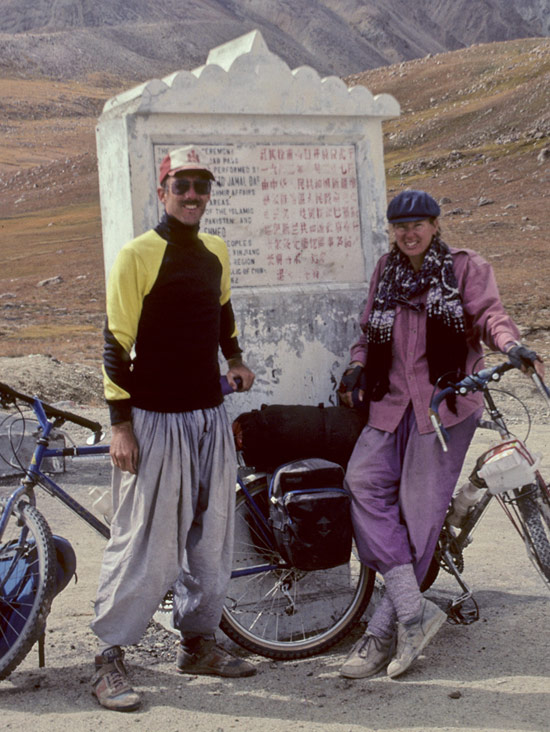
Nancy and John at the Khunjerabl Pass
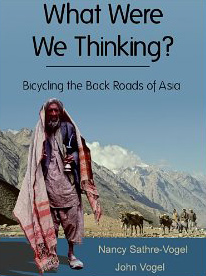 I just finished reading What Were We Thinking? by Nancy Sathre-Vogel and John Vogel and—after following along on their year-long cycling adventure through Asia—I have one pressing question: what were they thinking?!!
I just finished reading What Were We Thinking? by Nancy Sathre-Vogel and John Vogel and—after following along on their year-long cycling adventure through Asia—I have one pressing question: what were they thinking?!!
For those reading who aren’t familiar with Family on Bikes, they’ve just completed a 17,300-mile journey from Alaska to Argentina with their two young boys (on bicycles, just in case you didn’t catch that key detail). I was so inspired by this family’s epic accomplishment after reading their blog, that I considered doing a major bike tour myself. After all, if a family of 4 can achieve something like that, I can too … right?
Unlikely.
The book alone had me feeling as though I had dust in my lungs and bruises on my rear. After 308 enthralling pages of vicarious adventure, I desperately wanted a shower, a decent meal, a course of antibiotics, and a hug from my mother.
The journey begins in Pakistan with school kids trying to kill Nancy and John with rocks. Joy! From there, they cycle China, India, Nepal, and Bangladesh, enduring relentless hills, horrible illnesses, funky accommodations, and seemingly constant sexual advances from lecherous strangers. Double joy!
Despite the hardships, Nancy and John take everything in their stride. Instead of avoiding challenges, they gravitate towards them without fear, making me wonder how they’ve thus far managed to avoid winning their very own Darwin Award.
Of course, there’s plenty of beauty along the way too—from sleeping under the stars, to the snow-capped mountains of the Himalayas—so it’s easy to see what draws them to this slow and unique form of travel.
Cycling Asia may not be an adventure for the faint of heart or the weak of legs, but it does make for one hell of an interesting read. Through Nancy and John, I got to experience what life is like when you’re completely and utterly fearless.
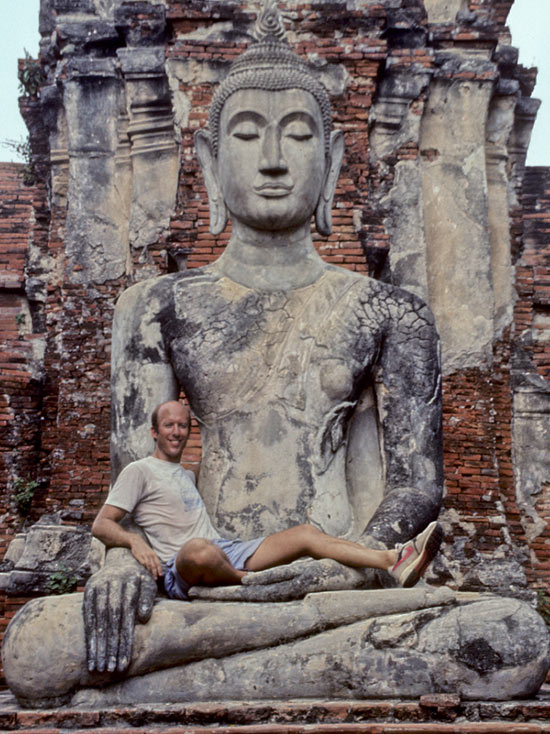
John with a Thai Buddha
I asked Nancy if she’d mind answering a few questions, and she kindly obliged:
An interview with Nancy Sathre-Vogel
What makes a person crazy enough to cycle across Asia?
Honestly, I wish I knew. When I went to Asia, I never dreamed it would be as challenging as it was. I had visions of nice, relaxing bikes rides through quaint rural villages. I pictured colorful Indian women with gold rings dangling from every part of their bodies welcoming me in to their villages and I’d… I don’t really know what I expected I’d do. I never thought that far ahead.
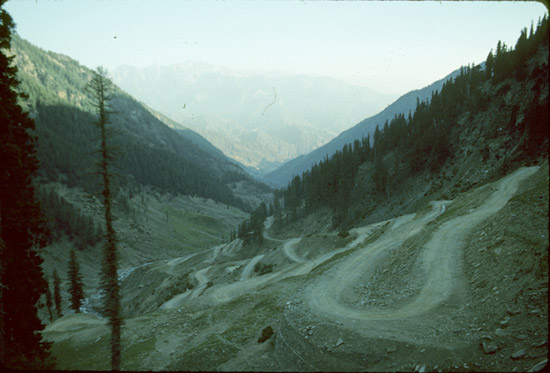
Lowry Pass
Do you have any idols? Is there any great adventurer who inspired you to pursue a life of travel and discovery?
The book that inspired my initial forays into bike touring was Miles From Nowhere by Barbara Savage. Barbara and her husband decided they would ride their bikes around the world – so they did. She paints a very vivid picture of life on the road and her writing encouraged me to hit the road.
If you were asking about some famous adventurer – no way. They were all true adventurers and were brave and fearless and strong – not like me at all. Barbara was like me.
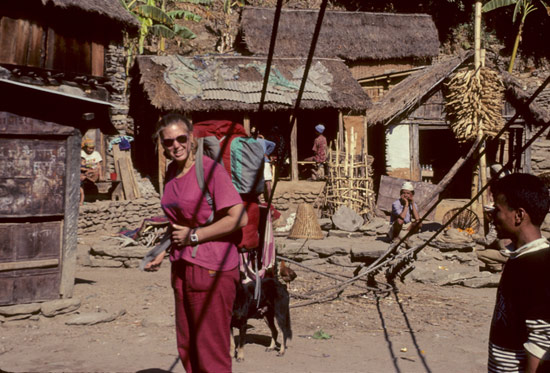
Nancy trekking
I was pleasantly surprised to discover the love story in your book. You’d expected to cycle Asia alone, but to appease your mother, you placed an ad in a travel magazine for a cycling partner. Then … along came John. In the beginning, there was some animosity between the two of you. (I can’t believe he drank all your water!) How did you go from stinky cycling partners to traveling lovers? When did you first realize you had a crush on him? Spill:
Oh gads! The romance started quite early on in the journey, but it was rocky at best. There were certainly moments when I viewed John as an intruder in my adventure and I’m sure he felt the same. He pushed me harder than I wanted to be pushed – I can’t tell you how many times I regretted my decision to travel with him.
The funny thing is that the thing that kept me with him was the camera. In the interest of weight, we had decided to travel with only one camera – and he had a better one than I did. Each time I considered heading off on my own, I remembered that I wouldn’t be able to take any pictures – so I stayed. I also realized that I didn’t know the first thing about taking care of a bike.
Even though he was a total jerk in many ways, he was also very thoughtful and considerate in others. Eventually I started seeing more of the caring, sympathetic side and less of the idiotic side.
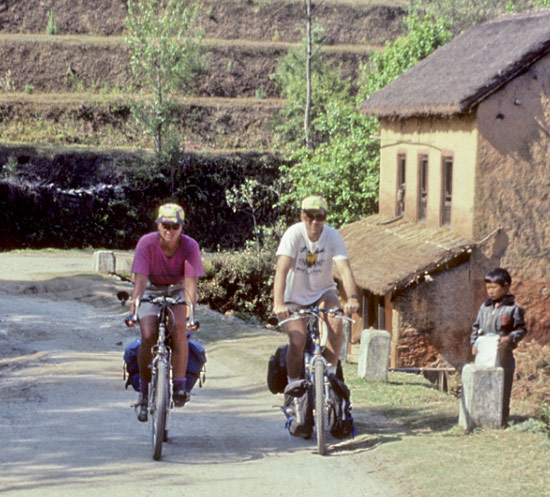
Nancy and John in Nepal
Do you ever think about what your trip would’ve been like if you had gone alone? Do you think you would’ve made it as far as you did?
There is no question that, had I gone alone, my journey would have been way different. I have no way of knowing, but I suspect I wouldn’t have cycled much at all – I would have found a village and stayed for a month or two before cycling to the next village. John was very motivated when it came to the cycling itself, whereas I simply wanted to use my bike as transport from one place to the next.
I do know that I would not have gone to Pakistan had I traveled by myself. I’m not sure where I would have gone, but probably just India and Nepal. Or maybe Thailand.
Do you believe in fate?
At the time of that journey, no. Now? Absolutely. There is no question that John and I were meant to come together. I mean – we placed ads in a Canadian magazine. We were the only two cycling Asia. We had the exact time frame. AND we lived 2 hours apart in New Mexico! What are the chances of that?
Which part of the trip was the most challenging? The hills? The illnesses? The accommodations? The mobs? The perverts?
As I look back on the journey now with the benefit of 21 years of hindsight, what sticks out in my mind as being hard was the lack of women in Pakistan. Prior to that journey I had not seen any difference between men and women. I would have told you that it made no difference if a smile came from a male or female.
As we cycled Pakistan, I got to the point where I craved seeing women’s faces. I wanted to see a woman smile or the sparkle in her eye. I wanted to reach out and hug another woman. There truly is a difference and being with men only was difficult.
John never did see that to the extent I did, although he certainly felt it. There were times when he would notice a woman before I did and point her out to me. It was like that woman’s face was a tiny ray of sunshine for both of us.
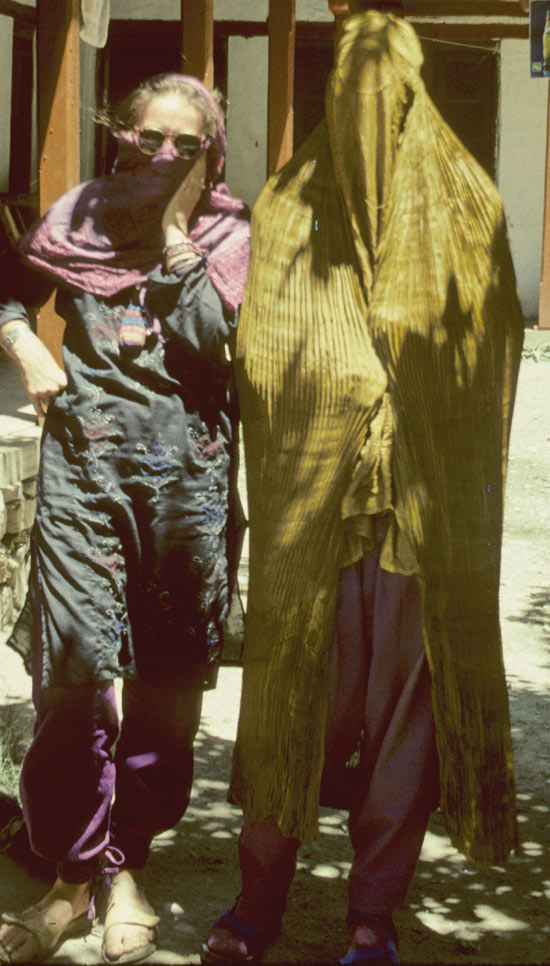
Nancy in a Burkha
What kept your legs pumping when the going got tough? When life on the road gets hard, what are you thinking about?
I think it comes down to choice. I had made the choice to ride my bike around Asia, so I rode my bike around Asia. When I’m climbing a killer hill or bouncing over terrible dirt roads it’s not all that fun, but the pain disappears quickly once I reach my destination. The pain is then replaced by a tremendous feeling of satisfaction that I did it! I conquered the challenge!
Each time I conquer a new challenge I know I can reach that level – so the next time it’s not nearly as difficult. If I could reach that place before, I can do it again. And if I can reach that level, I can probably push myself even farther – and I can.

Snow
At one point in the book, you and John go searching for a rhino, and you chance upon one that’s sleeping a distance away. Hoping for a good photo, John decides to wake up the rhino! He’s 15 feet away when the beast awakens and springs to its feet, so John turns and runs—but not before snapping a shot. After his brush with serious danger, he says to you: “Nancy, you have to go! It’s fun!”… and then you do! Clearly, you’re both utterly fearless. You grab the bull by the horns (or the rhino, in this case). I’m just wondering if you can bottle your fearlessness and sell it to me, or at least share a few words of wisdom for us fearful adventurers?
I think in that case it had nothing to do with fearlessness and everything to do with stupidity. ‘Nuff said.
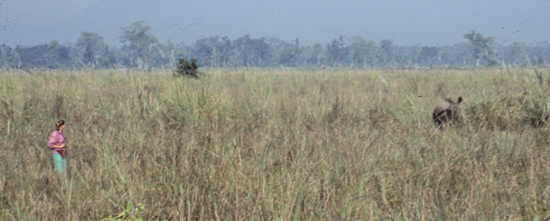
Nancy with the rhino
How does this trip compare to your experience of cycling from Alaska to Argentina with your two kids? Which one was more challenging, and why?
This is a tough question to answer! The two journeys were so totally different it’s like trying to compare apples and oranges. Or maybe a better analogy is comparing hamburgers with a desk lamp. They are animals of a completely different stripe.
Our Asian adventure happened when we were young and foolish. We had more guts than brains and never stopped to consider the folly of what we were doing. We just did it.
The Pan American Highway with our children was tame – very tame. John and I were older and (I like to think) wiser. We were on the downhill side of the whole body thing and our bodies didn’t necessarily do our bidding like they did twenty years earlier. We took the easy route and played it safe.
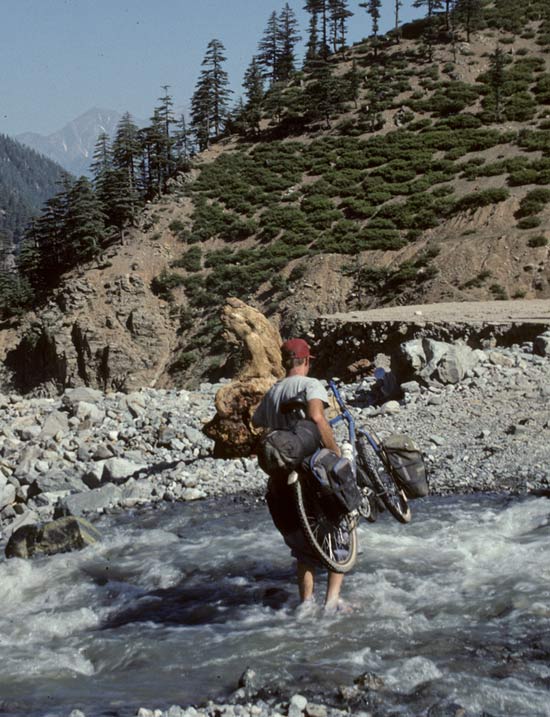
John crossing a river with his bike
Did your attitude to adventure change at all after you had your boys?
You bet! For a while there I bought the typical American parenthood thing hook, line, and sinker. I had my boys in soccer teams and swim teams. We followed the standard path of parenthood as much as we could. Yes, we were living overseas at the time so we traveled a fair bit more than most parents, but generally speaking we toed the line just as society expects.
When the boys were seven John suggested we quit our jobs and take off on our bikes. I was horrified. Speechless. Mortified. I mean – we were parents. With children. Parents with children don’t quit their jobs and ride bikes around the world. Right? That’s not what we’re supposed to do.
Once we made the decision to go for it, however, I realized how wrong I had been. Children are great travelers and are a delight to be around. I’ve loved my years on the road with the boys and can’t imagine it any other way.
Apart from the incredible experiences, what do you think you gained from this particular trip? Did you notice a significant change in your personality after returning home?
I think I learned that I could do anything. That was a very important lesson and one that I forgot all too soon – but it shaped my life for a few years before I did. I was strong, I was adventurous, I was invincible. It was that sense of invincibility that encouraged me to apply for jobs overseas – we spent a total of twelve years teaching in international schools after that.
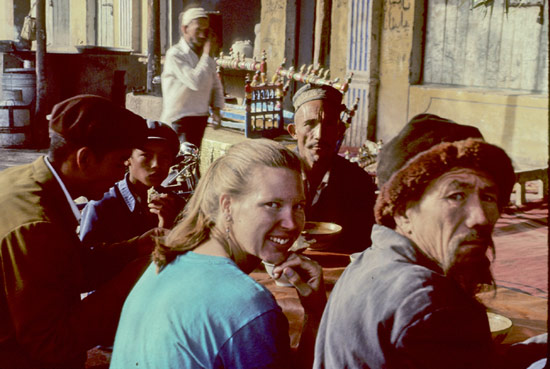
Nancy in China
There’s a part in the book where the two of you take a rowboat out onto the Ganges to watch the funeral processions. In vivid detail, John describes the Indian ritual of burning the dead on the river. What I found most amazing is that you don’t just go there once; you go to the river over and over to watch the funerals. At one point, you see a bloated, dead body float past your boat! This scene would be too confronting for most Westerners. I’m wondering: what drew you to that place for so many days? Was it curiosity, or was it something spiritual?
Varanasi was, without a doubt, the most spiritual place I’ve ever been. Just walking around the streets you feel an energy. A force of some kind. It’s everywhere.
By the time we got to Varanasi we had been in the area for five months and had seen how different the Indian world view was from ours. It wasn’t better or worse (OK – sometimes I felt it was worse, but…), just different. We wanted to understand it, even though we knew there was no way we could. We had grown up in a different universe and there was no way we could truly understand what was happening there.
Even so, we quickly learned that death wasn’t a negative thing in India. Death was a part of life just as much as a baby being born. It’s not something to be dreaded or feared, it’s just another phase in life. We wanted to understand that.
The burning ghat itself was powerful and we were fascinated by the rituals there, but what struck me more was the house for the dying. Old people near death traveled to Varanasi and stayed in a house just above the burning ghat while they waited to die – it was cheaper to transport a living body than a dead one. I was, in many ways, horrified by the house – the old people writhing in pain on their mats on the floor, the smell of burning bodies wafting in through the windows like a great big barbeque, the sizzle of burning flesh…
It was so very different from the way I had grown up and it was fascinating. I know it sounds very morbid to our western way of thinking, but to the Indian way of thinking, it isn’t at all.
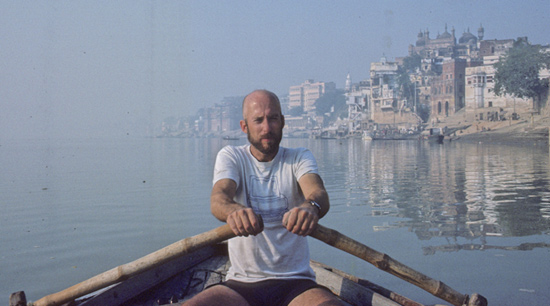
John rowing on the Ganges
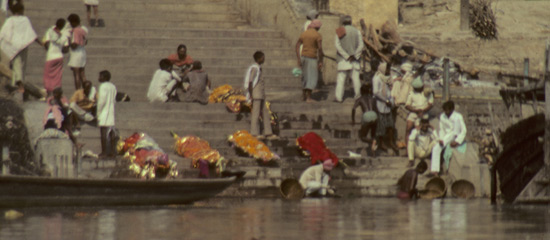
Burning Ghat
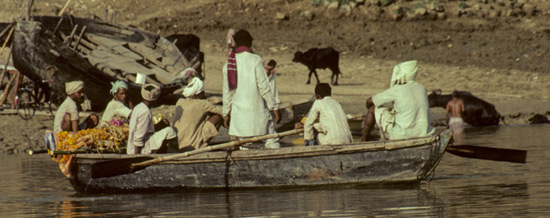
Poor man’s funeral
And one last question: how long did it take you two to write the book?
About two years. We arrived back in the USA in July 1991 and left for Egypt in August 1993. We were frantically trying to finish the book up before we left America.
Nancy and John—thank you so much for sharing your story. I’m looking forward to reading more!
You can find What Were We Thinking? on Amazon. Follow Nancy and John on Twitter, Facebook, or through their blog: Family on Bikes.
Torre DeRoche is the author of two travel memoirs, Love with a Chance of Drowning (2013) and The Worrier’s Guide to the End of the World (due out September 2017). She has written for The Atlantic, The Guardian Travel, The Sydney Morning Herald, Emirates, and two Lonely Planet anthologies.





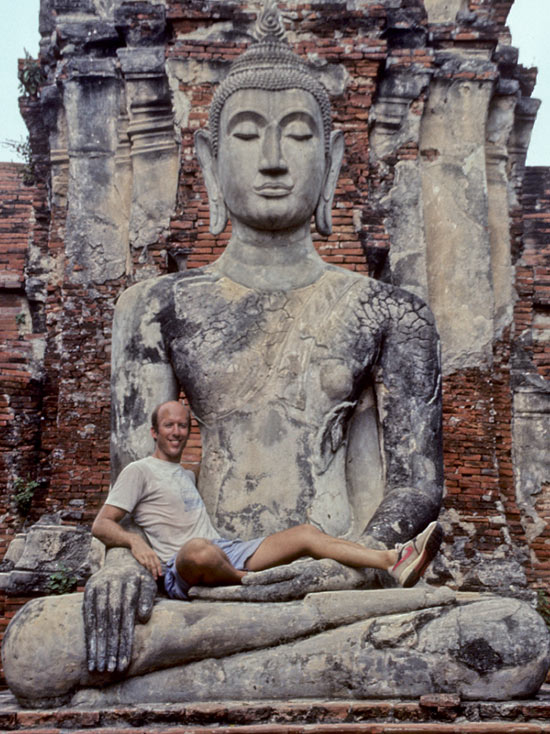
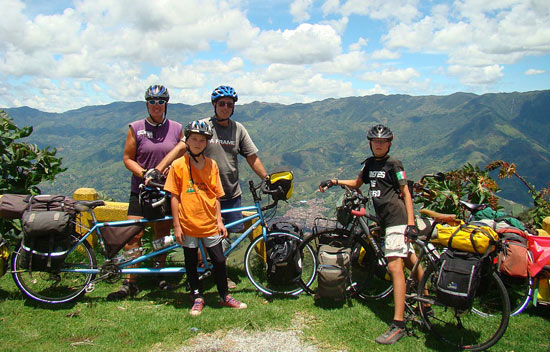
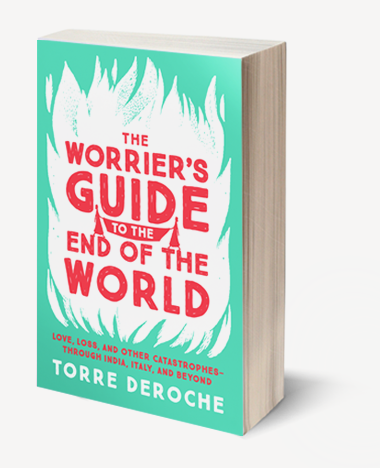







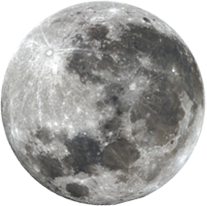
No Comment